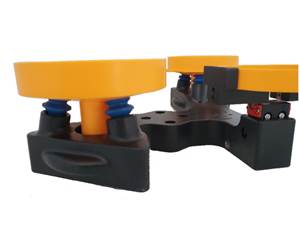Material Handling and Drying Are a Molder's 'Central' Issue
The benefits of centralized material handling have been demonstrated for decades, yet somehow the message continues to come slowly to mid-size processors like Jackson Products Inc of St.
The benefits of centralized material handling have been demonstrated for decades, yet somehow the message continues to come slowly to mid-size processors like Jackson Products Inc of St. Louis, Mo. This privately held firm makes personal safety gear for welding, construction, and industrial markets. At its plant in Belmont, Mich., Jackson molds parts for helmets, goggles, visors, and face shields on 21 injection presses from 90 to 720 tons. It uses up to 20 different materials and more than 30 colors.
By Jackson’s estimate it is a successful and profitable molder. But the firm realized that it executed poor management in handling its materials, and this had an impact on everything from efficiency in molding and scheduling to inventory, purchasing, and manpower, says Bob Czarnopis, manufacturing engineer. Over the past year, Jackson has become a convert to central handling and drying, joining what is still a small and exclusive club.
Internal audit reveals waste
Until last year, Jackson delivered material to each press independently, using wands stuffed into gaylords and beside-the-press dryers. Numerous inefficiencies resulted. Multiple dryers were running the same resin. Some presses pulled the same material from multiple gaylords. Misplaced inventory was common. “Unfinished boxes of material, which could have been used on another job at another press, instead went into inventory unlabeled or improperly labeled, making them hard to find for future use,” recalls Czarnopis.
Presses ran short of material. Bad parts were scrapped because of contaminated materials, use of the wrong material, and improper drying or color blending. A good deal of housekeeping was required around the machine for resin storage. The clutter around the presses caused inefficient use of floor space and possible safety hazards.
There were maintenance problems, too. Jackson had 10 press-side dryers and conveying systems that moved resins from the gaylord to the dryer or hopper. Upkeep of filters, electric motors, and conveying lines were frequent issues.
Savings came quickly
An in-house audit of its operations convinced Jackson to centralize its material handling and drying, a choice that is still quite rare, according to Gord Kaye, system group manager at Wittmann Inc., Torrington, Conn. “Approximately 55% of U.S. molders use central material handling, but only 3% to 5% centralize both handling and drying,” says Kaye.
Jackson invested $250,000 for material-handling equipment from Wittmann and for refurbishing the mezzanine where the system is installed. There is now a dedicated material line at every press to transport HDPE and a second line at each machine for any other material required. One central dryer delivers dry air to eight drying hoppers that were formerly used beside the presses. Each hopper has its own heater for independent temperature control. Materials are conveyed pneumatically to the machines from the drying hoppers or surge bins. The system moves about 600 lb/hr.
Jackson installed the system last April and expects an R.O.I. of 14 to 16 months. Quick savings came from upsizing its material purchases from gaylord to silo quantities. “Switching to bulk amounts immediately trimmed resin costs by 3¢ to 5¢/lb,” says Czarnopis. Better resin usage through improved handling and drying boosted total savings to approximately 20¢/lb.
Central handling and drying helped cut material inventory. “We eliminated 27 warehouse locations and material storage at the molding machines,” says Czarnopis. That left room to move mold storage from a central location to positions by the press, easing tool changes.
The central system also reduced the potential for resin spills. It brought about more accurate inventory control, better drying, and reduced downtime. Less tow-motor traffic through the plant improved worker safety. And one dedicated materials-handling person per shift was no longer needed.
Next, Jackson plans to program the system to start up drying before the first shift arrives. “We also want to see how we can automatically control shutdown at the end of the week to minimize inventory of dried resin at the machines,” says Czarnopis.
Related Content
PolyJohn Turns to Blow Molding, Doubles Its Productivity
Leading maker of portable sanitation products knew thermoforming, sheet extrusion, rotomolding and injection molding. Then it found the missing link to higher productivity and new markets: blow molding.
Read MoreWhat to Look for in High-Speed Automation for Pipette Production
Automation is a must-have for molders of pipettes. Make sure your supplier provides assurances of throughput and output, manpower utilization, floor space consumption and payback period.
Read MoreEnsuring Repeatability: The Key to Effective Injection Molding Automation
One of automation’s key promises is repeatability: the same movement to the same location, time and time again. But to achieve that, all elements involved — robot, machine, EOAT, mold — must be in and stay in alignment.
Read More'Smart,' Moisture-Based Drying Technology Enhanced
At NPE2024, Novatec relaunches DryerGenie with a goal to putting an end to drying based on time.
Read MoreRead Next
For PLASTICS' CEO Seaholm, NPE to Shine Light on Sustainability Successes
With advocacy, communication and sustainability as three main pillars, Seaholm leads a trade association to NPE that ‘is more active today than we have ever been.’
Read MoreSee Recyclers Close the Loop on Trade Show Production Scrap at NPE2024
A collaboration between show organizer PLASTICS, recycler CPR and size reduction experts WEIMA and Conair recovered and recycled all production scrap at NPE2024.
Read More









